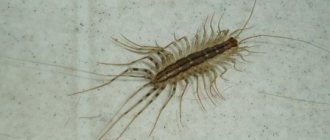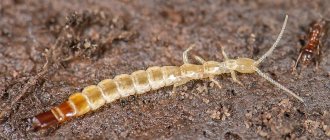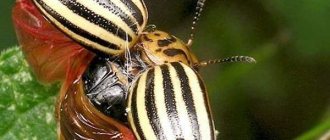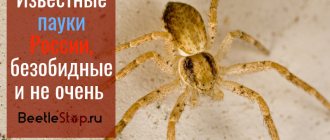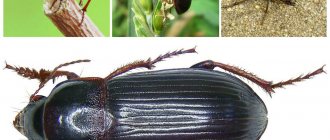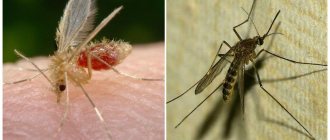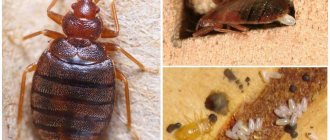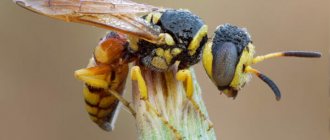What harm can an insect cause to a person?
In human homes, pintails usually hide under baseboards, in cracks in walls or floors, or in crawl spaces. Insects love to settle in bathrooms and other damp rooms with poor ventilation. At the same time, it is extremely rare to spot individuals, since they emerge from their hiding places mainly at night. When settling in a house, unwanted guests spoil food, indoor flowers, and even eat wallpaper paste. Penetrating into wall cracks, double tails gradually destroy building materials.
The bite of the double tail is dangerous for humans due to infection with viruses and pathogenic bacteria. After contact with an insect, the infection enters the bloodstream and the inflammatory process begins. When a pintail accidentally touches, it painfully pinches a person’s skin with its claws, after which small, itchy wounds remain on the body, the tissue around which becomes slightly swollen and red.
It is believed that this representative of insects is also dangerous because it crawls into the human ear canal at night, but in practice such cases are rather exceptional. The chance of a pintail getting into your ear is as low as getting a cockroach or fly there. This is only possible if there is a high population of earwigs in the home. To prevent the reproduction of insects, it is important to remove garbage in a timely manner and control the level of humidity in the apartment, eliminating sources of dampness.
Why is double-tailed tail dangerous: truth and myths
Double-tailed animals usually cause fear and disgust by their very appearance, but not everyone knows how dangerous double-tailed ones actually are. There is a misconception that it secretes a deadly poison, penetrates the human brain through the auricle, and eats it. But is this true? Let’s try to figure out further what harm a double-tail can cause to a home and a person and whether it is life-threatening.
We know the enemy by sight - the anatomical characteristics of the double tail
The two-tailed forktail is a harmful insect with an oblong body divided into segments and a red-brown color. Moves on six legs. The size of the antennae can reach ½ of the body. The two-tailed bird rarely uses its small wings.
Another popular name for the insect in question is the earwig. It is due to the fact that the two-tailed bird likes to settle in a person’s ear, penetrating there at night.
In place of the tail, chitinous formations grow, which are called cerci:
- in small specimens (from 2 to 3 cm) they are small and relatively thin;
- in two-easts of large size, the length of which exceeds 7 cm, the cerci are distinguished by strength, hardness, and power.
The forktail needs its stings (cerci) to capture and hold its prey. They squeeze their prey like a vice and bend (like scorpions), which makes it easier for the insect to eat.
Favorite habitat and food
For life, two-tailed birds choose a moist, cool environment. They really like pits with humus. Insects are very dexterous and move quickly. They go hunting in flocks at night.
With the help of claw-like growths, the forktail preys on miniature ticks, spiders, larvae of small insects, and centipedes. At the same time, he loves fruits, vegetables, even bread crumbs.
The pest has settled nearby!
Once in human homes, these insects hide in damp undergrounds, behind baseboards, between boards, and in cracks in walls. Two-tailed cats prefer to live in the bathroom, in rooms where ventilation is poor.
Warning! At home, this insect cannot be immediately detected, since it comes out of its shelter at night.
Appearing in the house, these unwanted guests begin to impudently manage it. They spoil almost all food products, indoor flowers, even wallpaper paste. Vegetable crops are destroyed. Penetrating into small crevices in walls, they contribute to their destruction.
Like other “biting” insects, forktails can be a source of infection with viruses and bacteria. When a carrier insect comes into contact with a person, the pathogenic microflora is introduced into the blood, and the infectious process starts.
When an insect accidentally touches an insect, it painfully pinches the person with its claws, leaving small, itchy wounds on the body for a long time, the surface turns red and slightly swells. You can see what a double-tailed bite looks like in the picture below:
It would be more correct to call a double-tailed bite a pinch - the insect pinches soft tissue with its claws. If the double tail is large enough, its sharp, hard cerci pierce the skin when grabbed, damaging its integrity - hence the marks of two points.
In cases of an allergic reaction due to a double-tailed bite, blisters filled with liquid appear at the site of damage to the skin.
An allergy can have serious consequences, it can be quite pronounced, and in the places where the double-tail was bitten and the blister burst, ulcers form that do not heal for many days, which cause significant discomfort and pain to the person.
First aid for a bite
Although the insect is not poisonous, the damage caused by it should not be ignored. The site of the bite on the skin must be:
- rinse thoroughly with clean water and soap;
- treat with a disinfectant (for example, alcohol).
You need to rush to the doctor when the bite of the doubletail is accompanied by allergy symptoms - the formation of blisters, burning, itching, deterioration in general well-being.
Insect control
You need to get rid of a specific “neighbor”. First of all, insect habitats are sanitized. You can resort to the services of sanitation workers. Chemical and folk remedies are used.
Chemistry against pest
A number of drugs containing chemical elements that are aggressive towards insects help to effectively combat double-tailed insects in a residential building. For example, insecticides are used:
- Solution "Anti-bug". Treat wooden surfaces. Apply with a brush or spray. It also destroys shashel and wood-boring beetles.
- "Raptor" (aerosol). The insects themselves, as well as their favorite habitats, are treated directly.
- “Mashenka” is a piece of chalk. It is harmless to humans and domestic animals, has no pungent odor, but has a fatal effect on almost all insects, including two-easted insects. Apply to floors and furniture.
Ordinary “Dichlorvos” also copes well with two-tailed water, after using which the room should be left for at least 5 hours and then thoroughly ventilated.
People's advice for the destruction of forktails
There are many folk methods of combating forktail. You can prepare an onion-garlic solution (make a paste from 50 grams of onion and garlic, dilute with boiling water, leave for a day). The composition is used to treat areas where beetles have infested.
Forktails are also afraid of certain herbs: wormwood, yarrow, tansy. An infusion is made from the plants and a little washing powder is added to it. The mixture is used to treat the areas of the room where the two-tailed bug has appeared.
Folk remedies, of course, do not always work 100%, but if you don’t want to introduce poisons into your home, you can start with safe, unconventional recipes.
Recommendation! Be sure to get rid of dampness and moisture in the room.
You can see forktails and find out what their harm is by following the links:
Source: https://beetlestop.ru/chem-opasna-dvuhvostka/
Consequences of a double-tailed bite
Pintails carry pathogenic microbes, which is dangerous for humans due to the risk of infection. The insect bite is painful and is also very itchy. Other symptoms by which you can recognize a double-tailed bite are:
- redness, swelling on the skin;
- at the puncture site there are two small holes left by the claws;
- after some time, a bubble filled with liquid forms on the wound (it later bursts).
The result of a doubletail bite is an allergic reaction that can have serious consequences. If blisters burst at the site of the skin puncture, long-term non-healing ulcers remain on the body, causing severe discomfort to the person. Such wounds are dangerous because they serve as gateways for secondary infections.
Are double tails dangerous for humans?
Other names: earwig, forktail. There are many varieties, so they can look different. However, all are united by the main feature - a body with a forked tail. Appear at night. These insects are capable of flight, but they rarely use this opportunity. They prefer a humid environment.
External signs
The two-tailed insect is an insect whose size varies from 0.5 to 7 cm. However, smaller individuals are more common. Despite its name, it does not have a tail, as such. There are only pincer-shaped chitinous processes - cerci. Their thickness varies depending on the type of insect. The larger the earwig, the denser the shoots. In males they look more like claws.
Males have curved "pincers" towards the center, while females have straight "arms".
The function of the eyes is performed by the mustache. They are sensitive, which allows the double-tail to move. The size of the mustache often corresponds to half the length of the body. The insect has no eyes.
The double-tailed cerci allow them to capture prey and defend themselves if danger threatens.
People don't often see earwigs because they crawl out at night and they live in hidden areas with high humidity levels.
Are double tails dangerous for humans?
It is generally accepted that these insects crawl into the ear during sleep. However, in practice this happens extremely rarely. The probability that a two-tailed bug will crawl into your ear is the same as in the case of cockroaches and flies, i.e.
small. This is facilitated by the high prevalence of insects throughout the facility. This means that if a forktail has gotten into your ear, you should put your home in order: normalize the humidity level, remove sources of dampness, and take out trash.
The insect bites, causing painful sensations. Small wounds appear on the spot. The bite of the double tail is not only painful, but also itchy. If you scratch the contact area intensively, a red spot and even swelling appears.
Some species also have wings and can fly, but they do so very lazily and rarely.
As a result of the bite, an allergic reaction occurs: blisters filled with liquid appear, then they burst, which provokes even more severe sensations.
Earwigs are carriers of pathogens, putting humans at risk of infection.
The stings are extremely painful and cause severe skin allergies.
In those rare cases when an insect crawls into the ear, the integrity of the internal auditory organs may be compromised. This occurs due to the effect of cerci on tissue.
It is necessary to take into account the risk of infection of wounds resulting from an allergic reaction of the human body to the bite of this insect.
Benefit or harm?
Earwigs are omnivores. They can eat plant foods: foliage, fruits, flowers. As a result, farmland suffers, as these insects attack vegetable crops and house plants. This leads to a decrease in yield and even death of plantings. If two-tailed insects enter the territory of human habitation, the wallpaper will suffer, as they eat wallpaper glue.
Earwigs also feed on molds and insects. By the way, this feature has a positive effect on the condition of housing and the garden, since two-tailed plants destroy pests and parasites.
At the same time, the condition of agricultural crops improves. In domestic conditions, these insects feed on any food, but still prefer fruits.
If necessary, double tails can even be stored in the refrigerator or bread bin.
Interesting video: Lifestyle, habits
Fighting methods
To remove earwigs from your home and yard, you must follow these guidelines:
- A layer of foliage and thick grass must be removed from the soil surface around the house. Insects love to hide here.
- Main routes of penetration: cracks and leaks in the walls and foundation of the building. If you fill all the cracks, the number of insects will decrease.
- Remove any source of dampness from the house. It is recommended to use a dehumidifier if the humidity level in the room is too high. Leaking plumbing fixtures need to be repaired.
- They are destroyed by birds and frogs. This means you need to install several birdhouses near the house.
In addition, various insecticides are used. They differ in efficiency and price, but it is quite possible to choose the most effective option:
- Dichlorvos. It destroys various insects, but it smells unpleasant and is toxic, which means that the treatment is carried out while wearing a protective mask.
- Aerosol Raptor. It has a more pleasant smell. It is characterized by toxicity, so you need to use personal protective equipment.
- Thiuram powder. It is scattered on the floor in places where the two-easted bird is likely to live.
- Anti-bug liquid. It is applied with a brush or sprayed. Recommended for processing wooden surfaces.
- Crayons with poison.
On the one hand, the earwig brings benefits - it destroys pests of agricultural crops. But on the other hand, it also affects the foliage and fruits of vegetable crops, flowers. This means that we can conclude that the danger is posed by a significant spread of the two-tailed bug around the house and garden.
(1 5,00 of 5) Loading...
Source: https://MrKlop.ru/nasekomye-v-kvartire/chem-opasna-dvuhvostka-dlya-cheloveka.html
What is the difference between a two-tailed earwig and an earwig?
Some people are used to calling two-tailed earwigs earwigs, but this is completely incorrect. The former are a species of insect that has nothing to do with earwigs. Let's look at their differences:
- Two-tailed fish are small arthropods that have a characteristic formation at the rear end of the body, looking like claws. The length of adult individuals does not exceed 0.5 cm (rarely, however, giants up to 5 cm long are found). There is no pigmentation on the segmented belly of the insect; in addition, the two-tailed insect has no eyes, the role of which is played by long sensitive antennae.
- Earwigs are representatives of Leatheroptera. They have an elongated, flat, brown body. The length of males reaches 1.7–2 cm, females - up to 1.4 cm. In nature, large individuals are sometimes found, the body length of which is more than 4 cm. Earwigs have small eyes, membranous wings and thread-like whiskers. Insects fly extremely rarely. A distinctive feature of earwigs is the claw-shaped processes (cerci) located at the end of the body.
Two-tails in large quantities have no practical benefit to humans. The possibility of being bitten and its unpleasant appearance frighten people, and food spoilage by insects makes life almost impossible. Who are the two-tails? Where do parasites get into the house and how to get rid of them?
Why are double tails dangerous for humans?
Earwigs are insects. Today, more than 1,700 species are known that can be found all over the world and all of them will have characteristic formations on the back of the abdomen in the form of “mites”, expressed to varying degrees from species to species.
Earwigs have been on the planet for at least 208 million years. They prefer dark, damp areas that provide them with shelter and food. They can often be found in forests, fields, gardens, courtyards and, of course, in the interior of a living space.
They easily get here through holes in the walls and crawl in search of a better life in the kitchen, bathroom, garages and basements. It’s worth noting right away that these insects are random guests here - they do not try to get comfortable in the wardrobe or under the mattress.
They got into living quarters, as already noted, absolutely by accident and, if the insect is not disturbed, it will go away on its own.
Among other things, earwigs can also be found on farmland and home gardens, where they cause minor damage by eating the tender, succulent stems and roots of young seedlings.
The main focus of our article today: is double-tailed - is it dangerous for humans?
We will talk about why an earwig bite is dangerous, what consequences it can have, and also list the most interesting facts about this type of insect, about which quite little is known, except that it is a threatening insect in appearance that appears periodically in residential premises of private houses. The information will be of interest to all our readers who want to know more about earwigs.
Are two-tailed earwigs dangerous for humans - interesting facts about earwigs
Many of us are accustomed to calling earwigs two-tailed. Although this is completely wrong. Two-tailed insects are a separate species of insects that have nothing to do with earwigs, but the latter are called so because of the characteristic formation at the rear end of the body in the form of tweezers. Further in the text, we will still use the term “two-tailed”, considering it general.
Earwigs are the slowest eaters when compared to other insect species of the same size.
They are also omnivores and tend to feed at night.
These insects eat plant products, for example, leaves, fruits, flowers and, of course, moldy fungi, as well as insects, including pest species, which is of great benefit to the garden plot.
The fact that the mouthparts of earwigs are able to chew food allows them to eat quite tough foods, for example, grind the protective chitinous covering of insects or the hard shell of a fruit.
Earwigs are well armed... with blank "cartridges". Each of us has seen earwigs. These are long, flat, narrow dark brown, black, reddish or yellowish insects. They are quite large in size - their length can range from 0.5 to 3 cm, depending on the specific species and stage of the life cycle. Like all insects, they have six legs and a pair of antennae.
Some species also have wings and can fly, but they do so very lazily and rarely. Earwigs' bodies are divided into three sections. At the end of the body, on the abdomen, there is a set of “tools” called cerci, which look like pincers, used by insects to catch prey or for defense. You can understand what we are talking about if you try to pick up an earwig with your bare hands.
Males wield curved "pincers" toward the center, while females' "arms" are straight. Another form of defense is a yellow-brown liquid that earwigs exude. Although it smells quite unpleasant, it is actually completely harmless. For this reason, the earwig can be considered the owner of a terrible, but unloaded weapon.
Earwigs become adults in just 20 days. Insects go through three stages of development, or metamorphosis: egg, pupa and adult.
An adult female earwig usually produces two batches of round, cream-colored eggs each year. Each batch contains up to 80 eggs. One of the most exciting facts is that it takes only 20 to 70 days for an insect to develop from an egg into a fully mature individual. The exact time depends largely on the ambient temperature.
Female earwigs are excellent mothers. Of all the facts, the most interesting is that female earwigs show signs of maternal instinct, which is practically unheard of in the insect world. The mother will remain with her eggs and nymphs for quite some time, fiercely protecting her offspring.
After the white nymphs are born, the mother earwig will remain with her babies throughout their five molts until adulthood. Usually by the time of 2-3 moults, young individuals can already find their own food and look after themselves, so the mother's attention gradually decreases.
Earwigs spend the winter in residential areas. Insects tend to live in dark, damp environments. They can often be found in large quantities under logs, leaves, in compost, but most of all they are found in the crevices of damp foundations of private houses.
If there is no opportunity to hide closer to human warmth, they are able to bury to a depth of a couple of tens of centimeters to avoid the cold.
Insects enter homes by crawling through cracks in walls and typically prefer damp, dark areas such as kitchens, bathrooms, garages and basements.
Earwigs are easy to get rid of. One of the most reassuring facts about earwigs is that if the presence of these insects is not pleasant to the owners of the house, they can be removed quite simply and you don’t even have to spend money on chemicals. There are some very simple steps that can be taken to control the earwig population.
Source: https://klopkan.ru/uhovertki/opasna-li-dvuhvostka/
Description of two-whiskers and earwigs
Diplura are arthropod wingless insects, recently introduced into a separate independent class, which includes subspecies such as projapygidae, campodeidae, and Japygidae. Distributed mainly in the tropical and subtropical parts of the planet. In Russia there are 20-30 species of Campodeidae, in the southern part of the country Japygidae. The average lifespan of the double-tailed insect is 12 months.
Appearance: body length 5-7 mm (in the class there are specimens 50 mm long), 6 pairs of legs, absence of eyes, elongated body, rounded head with antennae, the extreme appendages of the last abdominal segment are forked, claw-shaped, or elongated, have the ability to rapid recovery, the oral cavity is hidden inside the head, the color is light.
They choose a habitat with high humidity: rotten trees, forest litter, damp soil, large anthills, plant debris, greenhouses, compost pits.
Food: remains of other animals, insects, plant waste, leftover food, fruits, vegetables, shoots and leaves of plants.
The difference between the two-tailed earwig and the earwig
- Insects belong to different families.
- Body color and size.
- Earwigs have wings.
Double-tailed animals are unpleasant to humans due to their appearance. They carry various infections on their feet. They do not pose a threat to human life, but an adult pincer can bite noticeably without deeply piercing the skin with its claws.
Attention! The venom injected during the bite is not poisonous. But cases of allergies are possible: a painful blister appears at the site of the bite. You must seek medical help!
Two-tails in small quantities are beneficial. For example, they destroy aphids in the garden. But due to rapid reproduction, all planted crops begin to spoil.
Are there any benefits to earwigs?
As often happens in nature, it cannot be said that two-tailed insects are exclusively harmful insects. For example, these insects eat aphids, spider mites and other small pests.
However, one cannot say that this help is too noticeable. It is much easier to destroy both of these pests yourself, rather than breeding earwigs to eat aphids, and then fight with two-tailed insects.
How do two-tails get into housing?
- There is high humidity in the room (Causes: the room is poorly heated, there was a flood, poor ventilation).
- Dampness after leaks, moisture accumulation due to non-functional ventilation.
- Presence of cracks in the floor and foundation.
- Unclosed entrance doors.
- Cluttering with old unnecessary things.
- Repair (penetration through riser, basement).
- Moving from forests and countryside on clothing and animal fur.
- Open windows not covered with mosquito nets.
- Low-quality fruits and vegetables brought into the house.
- Insects are attracted to bright light at the entrance to the house.
How to get rid of double-east
These insects are afraid of unpleasant odors, spiders, heat, and high temperatures.
Chemical insect control agents:
- aerosol (Dichlorvos, Combat, Tarax, Kwik-byte, Pure lov);
pros: affordable price, high probability of impact;
disadvantages: paralyzing effect, they then come to life if they are not collected and destroyed, only affects adults.
- powders, crayons, gels (Mashenka, dust, Phenaxin, Tiuram):
advantages: low cost, minimal consumption over a large area, long-term exposure to two-way;
cons: not the best effectiveness, high percentage of possible drug poisoning by pets and small children.
pros: 100% action;
cons: suitable only for summer cottages and garden plots, requires careful preparation.
advantages: high efficiency, simplicity and accessibility;
disadvantages: suitable for a small area, causes dizziness and nausea, requires subsequent thorough cleaning, does not affect the offspring of insects.
- specialized disinfectants (AntiZhuk, Fitoverm, Karbofos, Intavir, Bankol, Clean House);
advantages: high efficiency, ability to process plants;
disadvantages: requires long-term ventilation and high-quality cleaning, dangerous to human health if used incorrectly.
- Herbs with a pungent odor (tansy, St. John's wort, mint, wormwood, yarrow) can help get rid of bivostok in the house by brewing and treating crevices and cracks with the prepared solution. Remember! Scented herbs take a long time to dissipate and can cause headaches.
- Traps (wet rags, damp newspapers, a small container greased with vegetable oil, a box with slots filled with garbage). Such devices are left overnight, the two-tails get into them at night, and get rid of them in the morning.
- Boiling water. Pour boiling water over homemade traps in the morning; insects cannot tolerate high temperatures.
- Onions and garlic repel parasites. You need to grind it to a paste consistency, add hot water.
- Baits with boric acid (laying boiled chicken egg yolks with boric acid in the favorite habitats of insects. Proportion for preparation: 1 yolk and 50 g of boric acid).
- Horseradish. You need to finely grate the root crop and place odorous baits to repel parasites.
- Petroleum-based liquids (gasoline, kerosene), concentrated bleach solution.
- Laundry soap. Use a spray bottle to spray the areas of occurrence with a highly concentrated solution. Finely grated soap can be added to herbal infusions to improve consistency.
- Balm “Star”. The pungent smell will scare away two-easters. You can use it to treat furniture legs.
- Vacuum cleaner (vacuum regularly in areas of accumulation, discarding disposable bags afterwards).
What does the two-tailed fish eat?
Photo: Double-tailed in the house
The digestive system of these creatures is very unique due to the structure of the oral apparatus. It is designed as a gnawing type and the mouthparts are directed forward, despite the fact that they are hidden in the head. The intestinal canal of the two-vost has the appearance of a simple tube.
The upper jaws are shaped like a serrated sickle and are of the grasping type. Only the very tips are visible from the outside, and the rest is hidden in recesses that have a complex shape and are called jaw pockets. The lower lip and pockets form a single unit. The upper jaws or mandibles, the mandibles, as well as the lower jaws, the maxillae, are hidden in the recesses. Japyxes, and many other species of forktails, are predators.
They feed on:
- smallest arthropod insects;
- bedbugs;
- springtails;
- springtails;
- nematodes;
- woodlice;
- centipedes;
- by his relatives, the Campodei;
- larvae.
Those forktails whose cerci are arranged in the form of claws, having grabbed the prey, arch their back so that the victim is in front of their head, then eat them. Some of the representatives are omnivores and feed on detritus, that is, the organic remains of invertebrate and vertebrate animals, particles of their secretions and undecomposed pieces of plants. Their diet also includes mushroom mycelium.
How to get rid of parasites in an apartment
In multi-storey buildings, they are most often found on the first floors: humidity and the proximity of the basement play a role.
- Clean up, remove dirty clothes, accumulations of unnecessary things, cleaning rags, etc.
- Ventilate the apartment thoroughly.
- Check the operation of the plumbing and ventilation systems.
- Fix all problems and leaks.
- Carry out general cleaning.
- Pay attention to food storage, the presence of undisposed food scraps and waste accumulations.
- To remove parasites, carefully treat places where insects accumulate, cracks in the floor, and hard-to-reach places in the bathroom and kitchen.
Can a double tail crawl into your ear?
To answer your question, you need to know how doubletails reproduce. In order to impregnate a male, the male captures her and holds her with his pincers, injecting his seed into her genitals. Eggs that have already formed in the female's genitals may not be fertilized immediately - the seed can be safely stored in the female's genitals for several months and only then eventually complete its main task of fertilization.
To lay eggs, the female earwig spends a very long time looking for a suitable place for this purpose. Conditions that are guaranteed to be necessary for this include darkness, optimal humidity levels and proximity to a food source. Female earwigs, like no other insects, are very caring about their offspring, which is very rare in the world of insects.
After hatching, young earwigs develop in a series of five molts, increasing in size each time. The mother earwig, unlike most non-social insects, actually protects her young, at least until it begins to make its first attempts to leave the nest, which is observed only after 2-3 molts. But even after this, mothers seriously care for their children, first of all protecting them from enemies.
While people may have long associated this insect with its tendency to crawl into ears, in reality this almost never happens.
However, this is still possible, but even if it happens, then in the space of the external auditory canal of a person there are no necessary conditions for laying eggs. Besides everything else, if we talk about the fact that an insect unnoticedly drills passages to the brain, then this cannot be discussed at all, since the presence of a foreign body, especially a living one, cannot pass unnoticed by a person.
Here is one of the stories with this insect:
“At 3 a.m., my 8-year-old daughter woke me up from a deep sleep. She was very upset. During the previous few minutes, she had attempted to independently remove “some living thing” that was crawling in her left ear canal. After that we became hysterical and went to the hospital. Otoscopic examination revealed the presence of a dark brown mass near the eardrum. The beginning of my brief lecture with my daughter about the importance of proper ear hygiene was interrupted when the doctor noticed movement. Upon closer examination, he was able to extract an insect about 2 cm long, which was an earwig.”
How to exterminate two-way in a private house
- Reduce lighting at the entrance.
- Close and caulk all cracks, crevices, holes in the floor and foundation.
- If possible, eliminate sources of dampness; all plants should be approximately 70-80 cm away from the house.
- Check the space under the floor for cleanliness, presence of wet places, and eliminate any defects.
- Treat the basement, foundation, hard-to-reach places in the house, and extensions within a radius of 5 meters with insecticides. The best time to spray chemicals is spring.
- Make sure that there are no animals or people in the house for 3-5 hours.
- Follow preventive measures.
How to drive two-east from a greenhouse
Two-tailed insects destroy young seedlings, eat the leaves of the shoots, and penetrate the fruits themselves. To combat two-tailed insects in greenhouses and greenhouses, you need to use different methods.
- Dig up the soil in the fall. In this case, the deposited larvae will not hatch, but will freeze.
- Replace all old boards with areas of rot.
- After planting the plants, regularly weed and loosen the soil.
- Plant aromatic herbs with a strong smell (mint, basil)
- Avoid the accumulation of plant debris in and around the greenhouse at any time of the year.
- Avoid keeping the soil too wet and reduce watering as much as possible.
- Ventilate the greenhouse.
- Treat the plants with microbiological preparations (Lepidocide, Bitaxibacillin).
- Use available folk remedies.
- If there are a large number of bivosts, it is not possible to remove them with biological preparations or use insecticides.
- Be sure to spray hard-to-reach areas of the greenhouse with high-quality preparations after harvesting.
Important! If the measures taken do not bring results, you need to call the sanitary service.
Prevention of the appearance of double-easted
- High-quality ventilation.
- Regular ventilation.
- Timely plumbing repairs.
- Equip all windows with insect screens.
- Reduce humidity at home. In places where condensation accumulates, you can place the most accessible absorbents: cat litter, salt, etc. Avoid drying clothes in the house.
- Cleanliness in the dining area and kitchen. Sealed packaging of products for storage.
- Maintaining cleanliness and order in the premises.
- Use of industrial dehumidifiers.
- Timely waste disposal.
- Cleaning of plant debris around the perimeter of cottages, greenhouses, outbuildings.
- Preventive treatment in the autumn.
- It is better to poison insects in the spring, when their activity is high.
- Do not leave compositions of summer fruits and berries in the public domain.
Earwigs and doubletails are different insects. They are often confused due to their similar lifestyle and identical tails. Insects multiply quickly, a huge population will quickly occupy the refrigerator, ruin the harvest, and cause a lot of trouble. To combat double-tailed insects, you need to use a combination of chemical and biological methods.
Common mistakes
Now let’s look at what mistakes summer residents most often make when fighting leatherbacks.
- Treatment of residential premises with strong chemicals. If you decide to get rid of double-east in a radical way, then be sure to take all precautions. Children and pets must not be present in the room during treatment.
- Ignoring the problem. Of course, you shouldn’t panic when you see one earwig. It is likely that she got into the house by accident. But, if insects begin to appear too often, then this is a reason to think about getting your house in order.
- Prevention is not carried out. Even if you use traps and crayons against two-wests, but do not take preventive measures, the fight will be in vain. New pests will take the place of dead pests, because your home has ideal living conditions for two-easters.
- Insect control is carried out incorrectly. All insecticidal agents only help to localize the problem. The main way to combat double-tailed insects is to keep your home clean and tidy.
Earwig - why is it called that?
The earwig is a small insect somewhat similar to a cockroach. At the posterior end of its body, characteristic pincer-shaped processes are visible. Thanks to this, another name for the earwig is widely known - the two-tailed cockroach or two-tailed cockroach. The insect uses these limbs as weapons for self-defense. When danger approaches, the earwig extends its processes towards the potential threat and can pinch quite sensitively with them.
The second purpose of the “tongs” is a mechanism for holding prey. The length of the insect reaches 1.5 - 3 cm. The earwig has membranous wings, some of its subspecies even have two pairs of wings, but it moves mainly on the ground.
The insect owes its name to a fairly persistent myth that it likes to crawl into a person’s ear. In fact, such cases are no more common with earwigs than with any other small insects.
What to do if bitten by a two-tailed fish?
Many different insects live in a person’s neighborhood (see What to do if there are cockroaches). Some of them look scary and can be dangerous to people. One of these creatures is the two-tailed insect - an insect that loves to settle in people’s homes and frightens household members with its appearance.
Is a double-tailed snake bite dangerous and what to do if it attacks?
The two-tailed insect belongs to the order of hymenoptera arthropods. Since ancient times, many legends have been written about it: two-tailed beetles are capable of climbing into the auricle of a sleeping person, laying eggs there, after which their larvae can enter the brain and cause the death of the victim.
In addition, it was believed that the insect had strong poison, and their bite was extremely dangerous for people.
Who are the two-tails?
In nature, there are more than 1,700 species of two-easted. Insects also have other names: earwig, forktail. The size of arthropods ranges from 0.5 to 4 cm in length and depends on the specific species.
The two-tails owe their name to their claw-shaped tail, which serves as protection against attack by an insect, and also serves as a kind of retainer for a victim caught by an earwig.
The scientific name for a forked tail is cerci.
Two-tailed animals have a color from light brown to yellow, 6 pairs of legs and two antennae. Insects feed using jaws adapted only for eating plant foods.
Sometimes two-tailed birds are not averse to eating small insects and leftover food in a person’s house. Forktails live mainly in damp rooms, cracks in the foundations of houses, under rotten trees, and moss.
Arthropods are often found in gardening areas, where they are pests of fertile trees and young seedlings.
Earwigs enter a person's home through holes in walls, floors, and windows. If potted flowers are present in people's homes, two-tailed beetles settle in the soil of plants, eating the roots and shoots of indoor flowers. Often, uninvited guests can be found in bathrooms, basements, cellars - where dampness and humidity are constantly present.
what does a double-tailed bite look like on the human body.
Double-easted females are excellent mothers. Few other insects care for their offspring as much as forktails. The fertilized female digs a shallow hole and then lays up to 80 eggs.
Until the eggs mature and small insects emerge from them, the mother will constantly be near them. After the tiny double-easted birds hatch, their mother remains with the offspring for some time, protects them from enemies, and then leaves her children forever.
Young doubletails begin to independently look for food and secluded places for burrows.
All about spider bites: symptoms, first aid, treatment.
Find out what to do if you are bitten by a tarantula: first aid, treatment of consequences.
With the onset of cold weather, earwigs hibernate. To do this, insects dig shelters in the ground (about 1.5 m deep); in human housing, arthropods can hide all winter in secluded warm and humid corners.
What to do if an earwig bites you?
What does a doubletail bite look like? Forktails bite only in self-defense when the insect's life is in danger. If the earwig is left undisturbed, it will usually go away.
In frequent cases, it is young children who become victims of forktail attacks. Because of his curiosity, the child tries to catch the insect, as a result of which the earwig has to defend itself. It is easy to recognize a double-tailed bite (see.
Insect bites), you just need to pay attention to the following symptoms:
- at the site of the bite, two small holes left by the insect’s tail are clearly visible;
- the affected area turns red, swells a little, and feels painful;
- after some time, a bubble filled with liquid may form on the wound, which subsequently bursts;
- The bitten area of the body is very itchy.
In some cases, after a double-tailed bite, unbearable pain and burning are felt, and red spots appear on the skin. All this indicates an allergic reaction from insect saliva entering the wound (see Allergy to bites). If first aid does not give positive results and the allergy does not go away, you should immediately consult a doctor.
First aid for bites
As soon as the symptoms of a double-tailed bite are noticed, the victim must be provided with timely treatment:
- The wound should be washed with running water and blotted with a sterile cloth.
- Wipe the bite site with an alcohol-containing composition (brilliant paint, cologne); a weak solution of potassium permanganate is also suitable.
- It is recommended to apply an adhesive plaster to the treated wound.
- To prevent an allergic reaction, the bitten person is given any antihistamine to drink.
- If the bite is very painful, the victim should take painkillers or apply ice or a bottle of cold water to the affected area.
Why is a double-tailed bite dangerous? Arthropods feed mainly on rotten plants, and less often on insects, so the wound formed after an arthropod bite must be treated as quickly as possible. If this is not done, there is a risk of penetration of pathogenic microflora, which will subsequently lead to an inflammatory process and suppuration.
Photos of the symptoms of the consequences of a double-tailed bite.
How to get rid of forktail
Despite the frightening legends about earwigs, insects pose absolutely no danger to humans. Many people still think that two-tailed fish are capable of crawling into the ear canal of a sleeping person and laying eggs there.
In fact, any insect can get into people's ears, be it a spider, a fly or a forktail.
As for the latter, the arthropod will not lay future offspring in the ear canal of the victim; for these purposes, the two-tailed one requires warm and moist soil.
However, living with arthropods is unpleasant, so many people wonder how to get rid of forktails in the house. In fact, dealing with earwigs is much easier than dealing with cockroaches or bedbugs.
Read what a midge bite looks like: signs, help.
Find out what to do if you are bitten by a mosquito: medicines and traditional methods.
Everything about mosquito bites in a child: symptoms, first aid for allergic reactions and itching.
Infusion of onion and garlic
The persistent and pungent smell of garlic and onions will force insects to leave a person’s home. To prepare the infusion, chop the head of onion and garlic and add up to a liter of boiling water to the resulting slurry. The infusion should stand for about 24 hours. The product is used to treat baseboards, cracks, walls, and wash floors and windows.
Trap
Since earwigs love a moist environment, a wet rag or newspaper, which must be placed where the insects live, will help get rid of them. As biwort accumulates on a wet trap, a rag or newspaper is periodically shaken off into the street.
In addition to folk remedies, modern drugs against annoying insects will help overcome uninvited guests: Dichlorvos (see Dichlorvos poisoning), Karbofos, Thiuram, a fumigator with plates against mosquitoes and flies.
Important! In order to prevent double-tails from returning, you need to seal all the cracks and chips in your apartment or house, get rid of rotting plants and wet rags.
Where does the earwig live?
The insect lives mainly outdoors, preferring damp and cool places: accumulations of withered leaves, compost pits, as well as various crevices and depressions (for example, under fallen trees or stones). The insect is active mainly at night.
Less commonly, earwigs are found in residential areas. However, in village or private residential buildings, insects are not such a rare guest.
The earwig is an omnivorous insect. Its diet includes honey, beebread, as well as various garden and vegetable crops. The earwig feeds on both fruits and leaves and stems of plants. All this makes the insect a rather dangerous garden pest.
The earwig reproduces by laying eggs; as a rule, the female lays up to 60 eggs. The eggs hatch into larvae that later grow into adult insects. The entire process of transformation from egg to adult occurs within one year. The eggs are laid by the female in late summer or early autumn. The first larvae appear in May-June.
Where do double tails come from?
Two-tailed insects live and reproduce in the soil and on its surface, so insects are found indoors quite rarely and, most often, by accident. Where do double tails come from?
- Insects can come from the dacha with you on cut flowers, lettuce, and herbs.
- Find yourself in the harvest.
- Live in a bouquet, seedlings or indoor plants that you recently brought into the house.
- In private buildings and on the first floors of apartment buildings, two-tailed birds can crawl independently through open windows and vents in the warm season.
- If two-tailed animals live in a heated basement, they can crawl into the apartment through ventilation, garbage chutes and elevator shafts.
- Two-tailed insects can get into the house by accident, ending up on shoes or pet fur after a walk.
In the Central region of Russia, two-tailed insects are active in the warm season, so the appearance and increase in the number of these insects occurs mainly in late spring, summer and early autumn, depending on the temperatures of the current season.
How to deal with earwigs in your garden?
To combat pests, experts recommend a number of effective measures. First of all, it is recommended to dig up the garden plot periodically, according to the seasons (spring-autumn). Using this method, you can get rid of eggs, larvae, and overwintering adult insects.
In addition, it is necessary to keep the area in order: remove withered leaves, tops and other plant waste.
Various traps are quite effective in the fight against earwigs. The trap is set up as follows: inverted containers (flower pots or cans) are placed around the area, various bait (branches, tops, grain) is placed next to and inside the containers. The containers can be lubricated from the inside with vegetable oil. The insects become trapped and cannot escape. They can be destroyed in any way of your choice (burn, pour boiling water or crush).
Gardeners often use other methods, such as repelling earwigs. To repel, various tinctures with a pungent odor that insects do not like are used. Essences based on vinegar, onion and garlic, wormwood or tansy are used as solutions for treating plantings and surrounding areas. Using a sprayer or spray bottle, foliage, plant stems, boxes and bed fences are treated.
Instead of homemade solutions, you can use specialized pesticides to control pests.
Features of the fight against earwigs in a residential area
Fighting earwigs inside an apartment or residential building is not much different from fighting ordinary cockroaches. Among folk remedies, the most popular is the use of beads based on boric acid and egg yolk. However, when using this method, it is necessary to limit the access of insects to water, otherwise it will not help.
Various household poisons will effectively help in the fight against earwigs, among which the most popular is ordinary dichlorvos. It is necessary to treat with poison places where insects potentially live: crevices, depressions, cracks.
It is also recommended to get rid of potential insect habitats: seal cracks and holes, and also keep the house tidy and dry.

